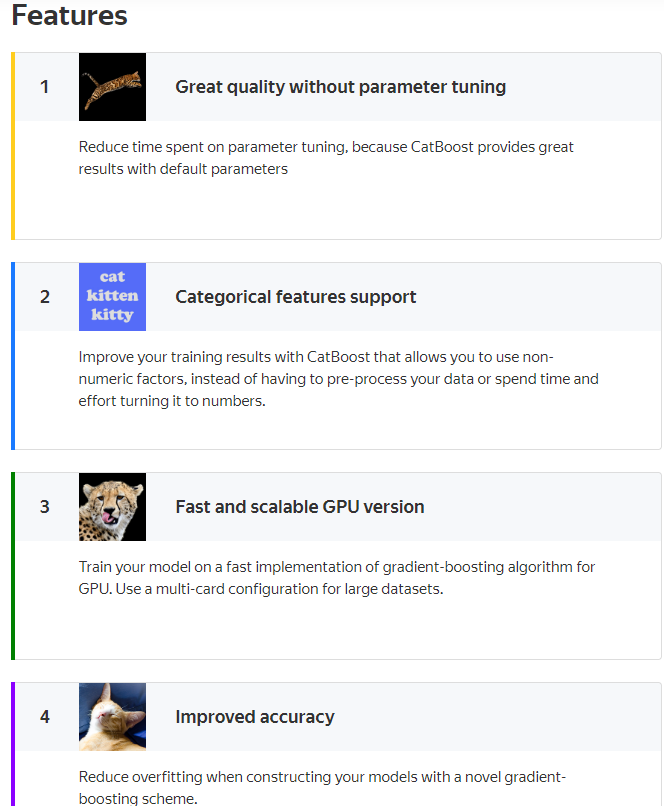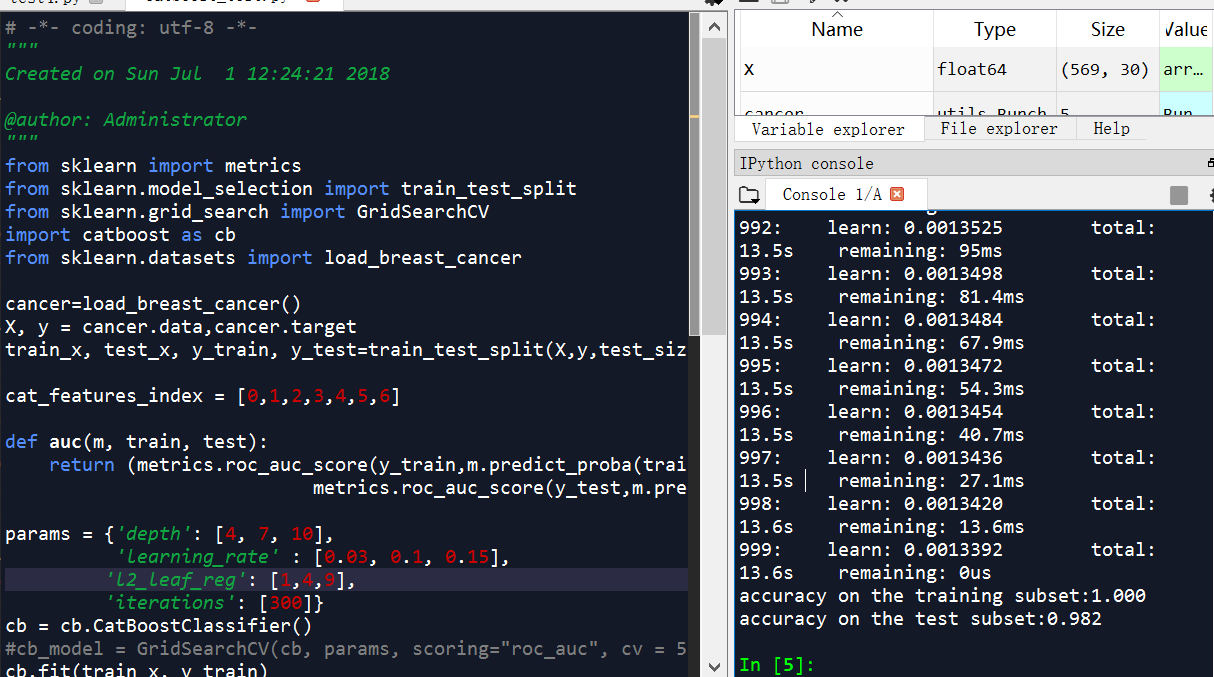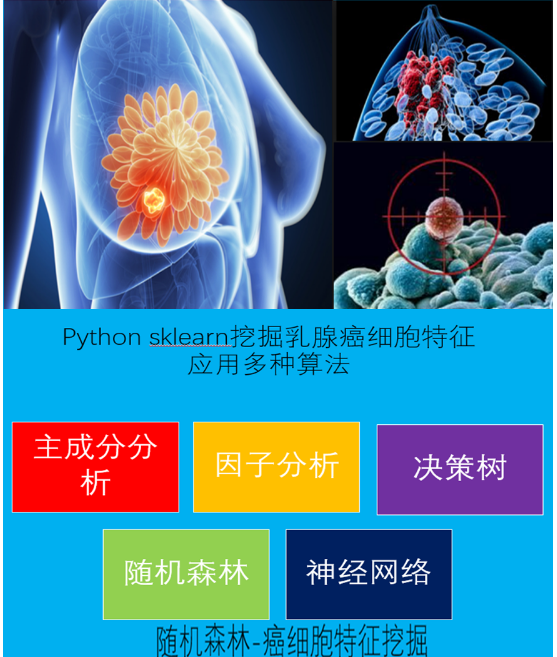python风控建模实战lendingClub(博主录制,catboost,lightgbm建模,2K超清分辨率)
https://study.163.com/course/courseMain.htm?courseId=1005988013&share=2&shareId=400000000398149
catboost官网文档
catboost GPU官方文档
https://catboost.ai/docs/features/training-on-gpu.html
catboost特点:
少量或无需调参,默认参数效果非常好
支持分类变量
支持GPU

catboost代码举例
# -*- coding: utf-8 -*-
"""
Created on Sun Jul 1 12:24:21 2018
@author: Administrator
"""
from sklearn import metrics
from sklearn.model_selection import train_test_split
from sklearn.grid_search import GridSearchCV
import catboost as cb
from sklearn.datasets import load_breast_cancer
cancer=load_breast_cancer()
X, y = cancer.data,cancer.target
train_x, test_x, y_train, y_test=train_test_split(X,y,test_size=0.3,random_state=0)
cat_features_index = [0,1,2,3,4,5,6]
def auc(m, train, test):
return (metrics.roc_auc_score(y_train,m.predict_proba(train)[:,1]),
metrics.roc_auc_score(y_test,m.predict_proba(test)[:,1]))
params = {'depth': [4, 7, 10],
'learning_rate' : [0.03, 0.1, 0.15],
'l2_leaf_reg': [1,4,9],
'iterations': [300]}
cb = cb.CatBoostClassifier()
#cb_model = GridSearchCV(cb, params, scoring="roc_auc", cv = 5)
cb.fit(train_x, y_train)
print("accuracy on the training subset:{:.3f}".format(cb.score(train_x,y_train)))
print("accuracy on the test subset:{:.3f}".format(cb.score(test_x,y_test)))
'''
accuracy on the training subset:1.000
accuracy on the test subset:0.982
'''
俄罗斯最大搜索引擎Yandex开源了一款梯度提升机器学习库CatBoost
摘要: 俄罗斯搜索巨头Yandex宣布,将向开源社区提交一款梯度提升机器学习库CatBoost。它能够在数据稀疏的情况下“教”机器学习。特别是在没有像视频、文本、图像这类感官型数据的时候,CatBoost也能根据事务型数据或历史数据进行操作。
CatBoost参数解释和实战
据开发者所说超越Lightgbm和XGBoost的又一个神器,不过具体性能,还要看在比赛中的表现了。
整理一下里面简单的教程和参数介绍,很多参数不是那种重要,只解释部分重要的参数,训练时需要重点考虑的。
import numpy as np
import catboost as cb
train_data = np.random.randint(0, 100, size=(100, 10))
train_label = np.random.randint(0, 2, size=(100))
test_data = np.random.randint(0,100, size=(50,10))
model = cb.CatBoostClassifier(iterations=2, depth=2, learning_rate=0.5, loss_function='Logloss',
logging_level='Verbose')
model.fit(train_data, train_label, cat_features=[0,2,5])
preds_class = model.predict(test_data)
preds_probs = model.predict_proba(test_data)
print('class = ',preds_class)
print('proba = ',preds_probs)
参数
CatBoostClassifier/CatBoostRegressor
通用参数
learning_rate(eta)=automatically
depth(max_depth)=6: 树的深度
l2_leaf_reg(reg_lambda)=3 L2正则化系数
n_estimators(num_boost_round)(num_trees=1000)=1000: 解决ml问题的树的最大数量
one_hot_max_size=2: 对于某些变量进行one-hot编码
loss_function=’Logloss’:
RMSE Logloss MAE CrossEntropy
custom_metric=None
RMSE Logloss MAE CrossEntropy Recall Precision F1 Accuracy AUC R2
eval_metric=Optimized objective
RMSE Logloss MAE CrossEntropy Recall Precision F1 Accuracy AUC R2
nan_mode=None:处理NAN的方法
Forbidden
Min
Max
1
2
3
leaf_estimation_method=None:迭代求解的方法,梯度和牛顿
Newton
Gradient
1
2
random_seed=None: 训练时候的随机种子
---------------------
性能参数
thread_count=-1:训练时所用的cpu/gpu核数
used_ram_limit=None:CTR问题,计算时的内存限制
gpu_ram_part=None:GPU内存限制
处理单元设置
task_type=CPU:训练的器件
devices=None:训练的GPU设备ID
counter_calc_method=None,
leaf_estimation_iterations=None,
use_best_model=None,
verbose=None,
model_size_reg=None,
rsm=None,
logging_level=None,
metric_period=None,
ctr_leaf_count_limit=None,
store_all_simple_ctr=None,
max_ctr_complexity=None,
has_time=None,
classes_count=None,
class_weights=None,
random_strength=None,
name=None,
ignored_features=None,
train_dir=None,
custom_loss=None,
bagging_temperature=None
border_count=None
feature_border_type=None,
save_snapshot=None,
snapshot_file=None,
fold_len_multiplier=None,
allow_writing_files=None,
final_ctr_computation_mode=None,
approx_on_full_history=None,
boosting_type=None,
simple_ctr=None,
combinations_ctr=None,
per_feature_ctr=None,
device_config=None,
bootstrap_type=None,
subsample=None,
colsample_bylevel=None,
random_state=None,
objective=None,
max_bin=None,
scale_pos_weight=None,
gpu_cat_features_storage=None,
data_partition=None
CatBoostClassifier
属性(attribute):
is_fitted_
tree_count_
feature_importances_
random_seed_
方法(method):
fit
X: 输入数据数据类型可以是,list; pandas.DataFrame; pandas.Series
y=None
cat_features=None: 拿来做处理的类别特征
sample_weight=None: 输入数据的样本权重
logging_level=None: 控制是否输出日志信息,或者何种信息
plot=False: 训练过程中,绘制,度量值,所用时间等
eval_set=None: 验证集合,数据类型list(X, y)tuples
baseline=None
use_best_model=None
verbose=None
predict
返回验证样本所属类别,数据类型为np.array
predict_proba
返回验证样本所属类别的概率,数据类型为np.array
get_feature_importance
eval_metrics
save_model
load_model
get_params
score
教程(tutorial)

catboost GPU版本
https://catboost.ai/docs/features/training-on-gpu.html
Training on GPU
CatBoost supports training on GPUs.
Choose the implementation for more details on the parameters that are required to start training on GPU.

Note. Other training parameters are also available. Some of them are CPU-specific or GPU-specific. See the Python package training parameters section for more details.
For example, use the following code to train a classification model on GPU:
GPU版本测试
# -*- coding: utf-8 -*-
"""
Created on Wed May 29 10:34:20 2019
@author: Administrator
GPU
1m -1m 2s
CPU
28.7s-28.8s
"""
from catboost import CatBoostClassifier
train_data = [[0, 3],
[4, 1],
[8, 1],
[9, 1]]
train_labels = [0, 0, 1, 1]
model = CatBoostClassifier(task_type = "GPU")
#model = CatBoostClassifier()
model.fit(train_data,
train_labels)
# -*- coding: utf-8 -*- """ Created on Wed May 22 10:50:59 2019 @author: Administrator CPU版本:3m 30s-3m 40s GPU版本:3m 33s-3m 34s """ from sklearn import metrics from sklearn.model_selection import train_test_split import catboost as cb from sklearn.datasets import load_breast_cancer cancer=load_breast_cancer() X, y = cancer.data,cancer.target train_x, test_x, y_train, y_test=train_test_split(X,y,test_size=0.3,random_state=0) cb = cb.CatBoostClassifier() #cb = cb.CatBoostClassifier(task_type="CPU") #cb = cb.CatBoostClassifier(task_type="GPU") cb.fit(train_x, y_train)
Python package installation
Installation is only supported by the 64-bit version of Python.
-
Choose an installation method:
-
-
(Optionally) Install additional packages for data visualization support.
-
(Optionally) Test CatBoost.
Note that there are additional system requirements if training on GPU is required.
GPU system requirements
The versions of CatBoost available from pip install and conda install have GPU support out-of-the-box.
Devices with compute capability 3.0 and higher are supported in compiled packages.
Training on GPU requires NVIDIA Driver of version 390.xx or higher.
-
Step 4 of the Build from source on Linux and macOS operation.
-
Step 3 of the Build from source on Windows operation.
python机器学习-乳腺癌细胞挖掘(博主亲自录制视频,含catboost算法讲解)
https://study.163.com/course/introduction.htm?courseId=1005269003&utm_campaign=commission&utm_source=cp-400000000398149&utm_medium=share
欢迎扫描和关注博主主页,学习python视频资源



